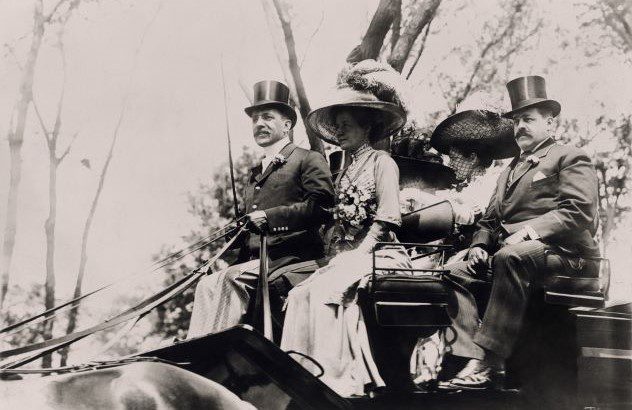 Mysteries
Mysteries  Mysteries
Mysteries  History
History 10 Surprising Stories About the Texas Rangers
 Humans
Humans 10 Philosophers Who Were Driven Mad by Their Own Theories
 Miscellaneous
Miscellaneous 10 Video-Game-Worthy Weapons and Armors from History
 Weird Stuff
Weird Stuff 10 Psychics Who Accurately Predicted Wartime Events
 The Arts
The Arts 10 Pieces of Art Inspired by a Broken Heart
 Health
Health 10 Science Fiction-Sounding New Medical Treatments
 History
History 10 Surprising Facts About the Father of Submarine Warfare
 Space
Space Ten Astonishing New Insights into Alien Worlds
 Weird Stuff
Weird Stuff 10 Bizarre Summer Solstice Rituals Still Practiced Today
 Mysteries
Mysteries Top 10 Haunting Facts About the Ghost Ship MV Alta
 History
History 10 Surprising Stories About the Texas Rangers
 Humans
Humans 10 Philosophers Who Were Driven Mad by Their Own Theories
Who's Behind Listverse?

Jamie Frater
Head Editor
Jamie founded Listverse due to an insatiable desire to share fascinating, obscure, and bizarre facts. He has been a guest speaker on numerous national radio and television stations and is a five time published author.
More About Us Miscellaneous
Miscellaneous 10 Video-Game-Worthy Weapons and Armors from History
 Weird Stuff
Weird Stuff 10 Psychics Who Accurately Predicted Wartime Events
 The Arts
The Arts 10 Pieces of Art Inspired by a Broken Heart
 Health
Health 10 Science Fiction-Sounding New Medical Treatments
 History
History 10 Surprising Facts About the Father of Submarine Warfare
 Space
Space Ten Astonishing New Insights into Alien Worlds
 Weird Stuff
Weird Stuff 10 Bizarre Summer Solstice Rituals Still Practiced Today
12 Horrifically Deadly Historic Heat Waves
Disastrous heat waves wreak havoc on millions of people every year. Sometimes, brutal heat can buckle roads and short-circuit critical infrastructure. Other waves tax energy supplies and leave millions living through difficult power outages. Sustained heat can cost farmers and growers billions of dollars in lost crops too.
Sadly, the very worst heat trends claim thousands of lives. The very old, the very young, and people who work outside are just some of the many groups affected by this severe heat. As the changing climate is increasingly felt in the most vulnerable parts of the world, the summer sun has become even more deadly. The heat bears down worldwide as first responders rush to help those most in need.
Unfortunately, many vulnerable people succumb to heat-related illnesses each year. In the worst cases, thousands die en masse as the sun refuses to relent. In many parts of the world, then, the heat is far more deadly than some minor inconvenience meant to avoid by running the air conditioning. In this list, you’ll learn about twelve of the deadliest and most damaging heat waves ever recorded throughout modern history.
Related: Top 10 Crazy Stories Of Weather Modification
12 1896 (Eastern U.S.)
New York City suffered one of the worst modern heat waves in 1896. In August of that year, temperatures rose well above 90°F (32.2°C) for days on end. Even worse, humidity rose above 90% every day too. At night, there was no wind and, thus, no break from the heat. Decades before air conditioning, New Yorkers suffered terribly. Across the Eastern Seaboard, residents languished.
Unfortunately, the conditions of the 1896 heat wave were made far worse by the living conditions in urban New York City. Tenements on the city’s Lower East Side already bulged with families. With five and six people in every room, living conditions had long been cramped. The heat made things even more unbearable.
Thousands of people sought refuge wherever they could get space. Some slept on rooftops. Others hunched on fire escapes. Still more spilled outside to the street level to seek better temperatures. They didn’t find them there. Plus, New York had a ban in place preventing people from sleeping in public. So cops pushed vulnerable people out of parks. Many sought shade in unwise and even dangerous areas. Some fell to their deaths from fire escapes and rooftops.
In total, more than 1,500 people died during the awful heat wave that August. Many deaths were from heatstroke, exhaustion, and other heat-related issues. But others came from falls high up on those fire escapes and rooftops. And still more drowned in the East River after trying to cool off before succumbing to the waterway’s strong currents. Interestingly, the heat wave did see one major unintended benefit: the rise of Theodore Roosevelt.
Roosevelt was the city’s police commissioner at the time. Among politicians of that era, he was one of the few people who sympathized with the working poor. That summer, he argued for the fair distribution of ice and water. He also cracked down on stores that he felt were price-gouging people trying to buy ice.
His push for reforms against dangerous tenement living was never forgotten by the people. Teddy’s work in the 1896 heat wave on behalf of the less fortunate helped push him to New York’s governorship two years later and, eventually, the Presidency.[1]
11 1901 (Eastern & Midwestern U.S.)

In 1901, much of America’s Eastern Seaboard and Midwestern Plains states buckled under a sustained heat wave. That July, extreme temperatures soared for days on end. In Bowling Green, Kentucky, residents experienced ten straight days of temperatures above 102°F (38.9°C). The wave was not only brutally hot but also far-reaching.
Nearly one thousand miles away, in New York City, about 750 people died of heat-related illnesses that month. In one week alone, more than 250 horses died from the heat too. For days on end, residents fled their homes and apartments in the city. Many took up temporary residence in the Big Apple’s parks. Doing whatever they could to find shade, they camped out under trees and limited their activity during the day. Reports from the time documented the “lunacy” many New Yorkers suffered in that awful period.
Nationwide that month, just under 10,000 people died because of the heat. To this day, it remains one of America’s worst heat waves on record.
Of course, the 1901 heat wave came about long before air conditioning was invented. The style of dress at the time was particularly difficult in summer too. Men were expected to wear jackets and hats. Even in the heat, they wore warm wool clothing. Women were pressured to remain modest and dress in layers too. As the temperatures soared, countless women fainted.
In St. Louis, several notable members of the fairer sex were reported dead after succumbing to two straight weeks of triple-digit temperatures. Even the reported inventor of the hot dog succumbed to St. Louis’s sickening heat wave.
As it was, treatments were very limited at the time. Hospitals offered ice and could produce more on demand, but that was about all they could do. Doctors ordered people to sit in ice baths and hydrate. Sadly, respite took weeks. It was well into August before the heat dissipated, and life slowly returned to normal.[2]
10 1936 (Midwestern U.S.)
The summer of 1936 is well known now as one of the worst periods of sustained heat in American history. The dusty, drought-like Dust Bowl conditions of the early 1930s were still wreaking havoc on farms across the Midwest. So when the heat set in that July, the Great Plains, Great Lakes, and nearby areas seriously suffered.
In Wisconsin and Iowa, temperatures soared above 110°F (43.3°C) degrees on both July 13 and 14. North Dakota recorded a temperature as high as 121°F (49.4°C)—then the hottest temperature ever recorded in North America. Wisconsin residents then suffered through nine more consecutive days of temperatures above 100°F (37.8°C). People wilted along with their worn-out plants as the sun beat down without end.
Americans were already struggling because of the Great Depression. For years by that point, many had little to eat. Others had inconsistent access to clean water. Air conditioning had recently been invented, but it wasn’t anywhere close to being standard in homes. In fact, it was mostly used in theaters and department stores. Those who could flocked to the big buildings. But many others downtrodden by the Depression were not so lucky.
The intense temperatures pushed the precarious situation over the edge. In total, more than 5,000 people died across the Great Plains states in July 1936. As the heat continued to destroy already-beaten crops, the government stepped in. Farmers were taught new irrigation and planting techniques to preserve topsoil.
In the long run, these farming changes helped the agriculture industry in countless ways. But in that awful summer of 1936, the heat proved deadly and relentless for millions in America.[3]
9 1980 (Southeastern U.S.)
The southeastern United States experienced an awful heat wave in the summer of 1980. Officially, around 1,260 people died from heat-related illnesses. But experts believe that number really exceeds 10,000 when indirect casualties are added. It all started in north Texas and the southern Plains states in July of that year.
The Dallas Metro area saw two days topping 113°F (45°C) at the very worst of the period. For days, the heat didn’t back off. Texas set new records for the most consecutive days above 100°F (37.8°C). By the end of it, Dallas residents had suffered through an almost-unimaginable 42 straight days in triple digits. Even now, locals look back with shock and horror at what they saw in the brutal summer of 1980. No recent heat patterns have come close to the endless ferocity of those awful six weeks in Texas.
People were feeling the heat elsewhere in the southeast too. In Alabama, the heat latched on to high humidity and made for a deadly atmospheric cauldron. Nearly all of Alabama sat above 100°F (37.8°C) for days. More than a quarter of the state’s population saw temperatures over 105°F (40.6°C). Along with hundreds of deaths directly attributed to the heat, Alabama’s agriculture suffered. Hundreds of thousands of chickens died, and half of the state’s corn crop withered.
The heat wave came at the height of the Cold War. Because it was so extreme, conspiracy-minded Americans wondered whether the Soviet Union was affecting the weather. That talk was crazy, of course, but the brutally hot air made people think something unnatural was going on. That the wave lasted so long only added fuel to that conspiratorial fire.
Cold War talk slowly dissipated, though. And eventually, so did the heat. After weeks of awful conditions, the summer sun started to recede in August, and life slowly got back to normal for those who had survived.[4]
8 1987 (Greece)
Not every heat wave has settled in North America. In fact, far more brutal summer temperatures have swollen elsewhere in the world. In Greece, July 1987 marked one of those unforgettable eras. That month, the temperature in Athens soared to 113°F (45°C). The average temperature for the entire month stayed near 100°F (37.8°C). The country entered a state of emergency after Greek citizens sought out help by the thousands.
Officials announced they were receiving more than 6,000 emergency calls about the heat every day. Hospitals struggled to keep up with the demand for services. At the time, most hospitals in Greece didn’t have access to air conditioning. So struggling locals would turn up for medical care only to find they couldn’t get their body temperatures back down into a safe range. Hospitals that typically dealt with four or five autopsies each day were suddenly dealing with more than two dozen every 24 hours.
One coroner recalled having to process 80 dead bodies in a single day. Many of the victims were elderly people already struggling with health issues. The soaring temperatures and subsequent dehydration made their conditions worse. For many, the sustained heat wave proved fatal. In total, more than 1,000 people died of heat-related issues in Greece that month.
Elsewhere in the Mediterranean, other countries suffered the devastating effects too. Across places like Italy, Albania, and Turkey, hospitals sent orderlies to fish markets to buy ice to preserve dead bodies. Sometimes they weren’t so lucky. For many coroners, burying the dead became a grisly ordeal.
The living were horribly affected too. Hospitals submerged suffering patients in bathtubs full of water. They placed as many as they could near electric fans to circulate cool air. In Turkey, more than 60 people drowned in bodies of water that month. They had been trying to escape temperatures that soared up to 122°F (50°C).
Meanwhile, tourism continued—for a while. British tourists trying to enjoy good summer weather had planned trips to Greece and Turkey months earlier. When they showed up, they, too, found the temperatures unbearable. At least two British women were listed among the Greek death toll that month. Even today, it remains one of the world’s nastiest and most persistent heat waves.[5]
7 1988 (Western U.S.)
The 1988 heat wave suffered across the Western United States was one of the most damaging ones on record for several reasons. Notably, it sparked the most destructive wildfire in the history of Yellowstone National Park. Amazingly, more than a third of the park was affected by the fire.
Flames ravaged tree lines and decimated green spaces for days on end. More than 300 bison, bears, and other large animals died in the awful inferno. Park officials tried in vain for days to beat back the blaze. When firefighters finally snuffed it out, they were lucky to avoid near-total destruction of the amazing open space.
Across the rest of the West and Midwest, the heat did more damage. Record temperatures were logged in 67 different cities across 23 states in middle America. From Tucson, which reached 114°F (45.6°C), to Sioux Falls, which logged 110°F (43.3°C), Americans suffered from weeks of awful furnace-like conditions.
In rural Nebraska, locals reported such intense heat that it caused highway pavement to buckle. One town in the Cornhusker State began drastically rationing water. Residents hunkered down and radically altered their lives to wait out the weather. Virtually all of the United States suffered under average temperatures that rose far above 90°F (32.2°C). For many areas, a sustained wave like that was extremely rare.
This heat wave wasn’t confined to just a few weeks, though. Instead, it brought along a drought that lasted for months. For more than four months, the drought cut down rainfall across the country by nearly half. By the middle of 1988, rainfall totals in America were at the lowest they’d ever been in the 20th century.
As you might expect, agricultural losses were massive. Across the year, they totaled more than $44.2 billion in scrapped food. That marks more than $111 billion in 2022 money.
In total, heat-related deaths were estimated to be at least 5,000 souls nationwide. Some estimates, including secondary causes of death exacerbated by the heat, held that more than 10,000 people perished. The relentless heat was of biblical proportions. Even today, Americans haven’t forgotten that awful summer.[6]
6 1995 (Chicago)
The Chicago heat wave of 1995 was brief, lasting just three days at its peak. But the effects were felt for weeks. And the death toll was shocking, considering the wave was relatively quick compared to some on this list. The temperature started rising on July 12, 1995. But at that day’s peak, it was just 97°F (36.1°C)—very hot, but still (somewhat) manageable. That all changed the next day.
A high-pressure system rode in on July 13 and raised temperatures to 106°F (41.1°C) in the city. The lakeside metropolis was full of brick buildings with tar roofs and thousands of asphalt streets. That caused the heat index to surge even higher. In some parts of the city, high heat and humidity combined to create a peak index of 125°F (51.7°C).
Over the next three days, those numbers stayed high. In the middle of July 13, the heat index registered above 120°F (48.9°C) for six straight hours. Chicago residents languished as the awful temperatures blasted the urban center.
In just three days of that heat, nearly 750 people died. On July 13 alone, first responders reported more than 16,000 citywide 911 calls about the heat. Emergency rooms went over capacity while responding to heat-related medical issues. Some hospitals stopped accepting new patients. As is often the case in heat waves, most victims were elderly people. Others were construction workers, gardeners, and others who worked outside.
City officials struggled to react to the heat as citizens suffered. Fire officials were slow to call in additional ambulances and paramedics. In that regard, they were lucky the heat subsided so quickly. Had it gone on longer, far more people would have died. Still, city officials didn’t take action afterward as they should have.
It took another brutal heat wave in 1999—which killed more than 100 people—for Chicago to start giving heat-illness training to first responders. The city also produced an extreme heat emergency preparedness plan. Sadly, those additions proved too late for the victims of 1995’s awful event.[7]
5 2002 (India)
Heat waves are nothing new in India. Many of the nation’s 1.3 billion people are used to oppressive heat every summer. But one week-long period in 2002 went far further than anything experienced before. From May 9 to May 15, 2002, more than one thousand Indians died due to excessive heat. Multiple areas of the country were affected, but the southern state of Andhra Pradesh was most severely hit.
There, the temperature rose as high as 124°F (51.1°C). Mud-thatched homes and tin-roofed buildings were made especially unbearable. Across the affected region, people found little relief from the heat. Hospitals were overloaded with cases of severe heat stroke. The death toll quickly rose above a thousand as people begged for respite.
If there was one saving grace through it all, it came in the country’s extensive experience with the heat. Government officials in Andhra Pradesh issued warnings very early in the process. They also provided water to the poor throughout the week. Non-essential services were cut for the time too. Millions of people were encouraged to stay home and wait it out.
Thankfully, the monsoon season was right behind the heat. With it came cooler winds and then heavy rains. Those severe storms brought their own issues, of course. But at least the heat wave had ended by then.
After the disaster, the Indian government took even further action by compensating the families of the deceased. It didn’t bring back their loved ones, of course, but the financial windfall was a nice gesture. After the summer season, officials were credited with decisive actions that kept the heat wave from affecting the population even worse.[8]
4 Europe (2003)
Europe doesn’t usually get heat waves like other places on Earth. But in the summer of 2003, Europe suffered through quite an ordeal. That July and August, more than 30,000 people died on the continent as the heat settled in. In many areas of France, recorded temperatures topped 99°F (37.2°C) for more than a week. Some areas of the country saw the mercury go as high as 104°F (40°C).
Nuclear power stations failed during the wave after high water temperatures and low water levels caused a crisis. Those failures happened at the worst time as millions of people were desperately pushing their electricity via air conditioning. As those systems stumbled, the death toll rose. In France alone, more than 14,000 people died in July and early August.
The rare European heat wave was caused by anticyclone winds that hung up over the continent. The rare wind pattern prevented moisture from accumulating. Rain wouldn’t fall for days as hot air stifled the region. In turn, temperatures soared 30% above average. Man-made pollution made it worse. Without wind, pollutants from cars and factories filtered into the air and stagnated.
Many of the ensuing casualties were blamed on poor air quality levels caused by the heat. Also, European nations were unprepared to battle the weather. Unlike places like India or the United States, most European countries had little experience with heat waves. As the temperatures persisted, environmental changes worsened too.
The Alpine glaciers shrunk by 10% in early August. Rock slides caused by the thawed ice put mountain residents at risk. Down in the plains, crop production faltered after irrigation buckled. The entire thing was a recipe for disaster. Finally, the wave relented in mid-August.[9]
3 2010 (Russia)
Russia’s heat wave in 2010 was, by far, the deadliest record heat wave of the modern era. In fact, it holds the Guinness World Record in that unfortunate category. Officials believe more than 56,000 Russians died from the heat that July. The death toll came in varied ways too.
Some of those victims died of heat stroke and heat exhaustion. Others were killed by severe drought conditions affecting food and water supplies. Still more lost their lives due to terrible forest fires that ravaged much of the country. Officials also recorded some deaths after people took to rivers and lakes to cool off, only to drown.
The heat persisted throughout July. Much of the country felt triple-digit temperatures. The highest-recorded mercury reading came out at 111.2°F (44°C) in the southern Russian republic of Kalmykia. Climatologists were amazed at how high the temperatures rose and remained during the summer. So they frantically started studying the weather patterns.
As it turned out, the heatwave was caused by something called atmospheric blocking. A high-pressure system shielded most of Russia from the cool air and precipitation coming in from the west. As those cold fronts were blocked, the heat settled in until conditions were unbearable. As the stove-like state persisted, Russian people became more frustrated with the Kremlin.
Citizens wondered whether the government was downplaying the death toll from the wave. Some people suspected Russian officials were instructing doctors to avoid listing heat stroke as a cause of death. Even today, some wonder whether the actual heat-related death toll was even higher than the 56,000 people reported.[10]
2 2015 (India & Pakistan)
Just like a few years before, India’s Andhra Pradesh suffered another awful heat wave in 2015. That summer, nearly 2,000 of its residents died. Elsewhere in India, another 600 more people perished. Some cities recorded absurdly high temperatures, including Delhi, which saw 118°F (47.8°C) at its peak.
Paved roads began to melt under the conditions. Taxi drivers were dying of heat stroke in their cars while working during the middle of the day. Most of the other victims were old, poor, or destitute. Many were homeless. As the poorest of Indian workers slept on concrete sidewalks and steel pipes, the heat claimed their lives.
Shocked at the conditions, the government began putting up stations with free water for citizens. As May slogged on, the heat persisted. By the end of the month, the monsoon rains had swooped in, ending the awful conditions. But for India, several thousand lives lost marked the awful weather’s deadly legacy.
Meanwhile, just to the west in Pakistan, the heat was just as bad. But while the monsoon rains brought relief to India that summer, its western neighbor never got it. More than a thousand people died in Pakistan in that same May 2015 heat wave. The country suffered widespread power outages after energy stations were overtaxed. Morgues, already filled to capacity, struggled to preserve bodies.
People flooded hospitals across the country, reporting heat-related health problems. The power outages extended to those medical centers too. That greatly complicated care and caused more deaths. As temperatures soared well above 110°F (43.3°C), the city of Karachi’s 22 million residents endured hours-long blackouts. The awful heatwave came during the holiday of Ramadan, which further complicated things.
Muslim Pakistanis were trying to adhere to restrictions about fasting from dawn to dusk. But the awful heat taxed millions of people’s health. Eventually, clerics allowed Muslims to break their fast if their life was in danger. That simple act saved thousands more lives as adherents were allowed to eat, drink, and recuperate amid the oppressive weather pattern.[11]
1 2022 (America & Europe)
A massive heat wave settled in both North America and Europe in the summer of 2022. In Wichita Falls, Texas, temperatures reached an unheard-of 115°F (46.1°C) on July 20. Rolling power outages and blackouts affected dozens of states. American roads buckled under the heat while hospitals and power grids were taxed for days on end.
At-risk individuals, many of them older and already vulnerable, collapsed in the miserable sun. Some perished as they couldn’t withstand the terrible temperatures. Compared to Europe, though, America got off easy.
Across the pond, the United Kingdom experienced its first-ever 104°F (40°C) day on July 19. The country essentially shut down after British officials asked everyone to stay home across the nation. Still, lots of emergencies inevitably came up. Fire departments across London answered thousands more emergency calls than usual. Most of them were heat-related.
The sheer volume meant many were difficult to follow up on during the worst of the wave. Considering just a paltry percentage of British people have home air conditioning, the sweltering temperatures made it much worse than what America had seen.
And it wasn’t just the United Kingdom that was severely affected. Across Spain and Portugal, more than 2,000 late-July deaths were directly attributed to the stifling heat. Thousands more had serious health problems that became worse after the heat taxed their bodies.
Now, climatologists are worried about how the changing climate may be altering high-pressure systems and radically enhancing heat waves like this in the future. As has been the case with many of the summer surges on this list, these intense future heat trends will severely affect society’s most vulnerable people: the old, the young, and those working outside in the tough conditions.[12]


![Top 10 Haunting Images Of Historic Tragedies [DISTURBING] Top 10 Haunting Images Of Historic Tragedies [DISTURBING]](https://listverse.com/wp-content/uploads/2020/05/33758v-150x150.jpg)





